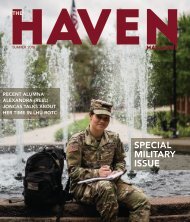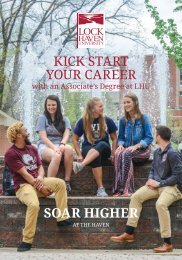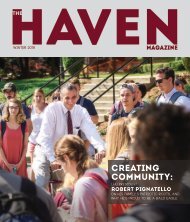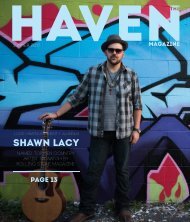The Haven Magazine Spring 2018
You also want an ePaper? Increase the reach of your titles
YUMPU automatically turns print PDFs into web optimized ePapers that Google loves.
drop in to a session of LHU<br />
Music Professor Mahlon<br />
Grass’s world music course<br />
and you’re likely to hear<br />
melodies from around the world. But<br />
that’s not the only thing that has Grass’s<br />
students excited about the course, it’s<br />
the opportunity to meet and interact<br />
with students from world music courses<br />
in other countries that has created<br />
unique learning connections.<br />
Grass has developed partnerships with<br />
universities in Ireland and Nova Scotia,<br />
Canada which bring together world<br />
music courses from each institution to<br />
learn about music and culture together.<br />
“When we work with classes in Ireland<br />
or Canada, we’re able to look directly<br />
at how that country’s compositions<br />
were influenced by American culture,”<br />
says Grass.<br />
Irish students spend a week presenting<br />
on their music and culture; LHU<br />
students access those presentations<br />
through the online D2L learning<br />
platform and then do the same for<br />
the Irish students. <strong>The</strong> online platform<br />
integrates text, narrative, slides, and<br />
audio and Dr. Grass is able to narrate<br />
the content for both American and<br />
Irish students. “It’s the next best thing<br />
to live study abroad for many of our<br />
students,” says Grass. “<strong>The</strong>y have the<br />
ability to interact with students from<br />
other cultures and to learn from one<br />
another in really meaningful ways.”<br />
<strong>The</strong> proof that students are responding<br />
is evident in more than the class signup<br />
rate. Grass says student learning<br />
outcomes have improved noticeably<br />
since the collaborations began. “I see<br />
technology as a way to connect with<br />
visual learners. When I introduced the<br />
technology components, the grade<br />
point average for the course went up<br />
10%.” Grass believes that’s because<br />
students are using tools they identify<br />
with in ways that allow for interesting<br />
connections.”<br />
“Students today want to interact. <strong>The</strong>y<br />
want to make connections. We see<br />
that in their use of social media. <strong>The</strong><br />
standard lecture doesn’t work for this<br />
generation of students and so it’s been<br />
Professor Mahlon Grass has developed innovative ways to connect with music students around the world.<br />
exciting for me to find ways to engage<br />
with them,” he shares.<br />
While he believes the high grade point<br />
averages are proof the students are<br />
connecting to the content, Grass says<br />
he can’t take credit in the shift. “It’s<br />
not because of me. It’s because they’re<br />
engaged and interested in what they’re<br />
learning—that has really made the<br />
difference.”<br />
allows them to interact directly with the<br />
instructor. <strong>The</strong> lectures are augmented<br />
with faculty and small group discussions<br />
at each campus.<br />
A majority of the learning is handson<br />
at each location in a model that<br />
Eisenhauer says embodies a studentcentered<br />
approach to case-based<br />
learning. He says, “Every campus<br />
“Students today want to interact. <strong>The</strong>y want to<br />
make connections. We see that in their use of<br />
social media. <strong>The</strong> standard lecture doesn’t work<br />
for this generation of students and so it’s been<br />
exciting for me to find ways to engage with them.”<br />
-Mahlon Grass<br />
since its start in 1996, the LHU<br />
physician assistant program<br />
has been a campus leader<br />
in integrating technology into the<br />
classroom. Much of the program’s use<br />
of technology focuses on bringing<br />
together the four campuses—LHU<br />
main, Clearfield, Coudersport, and<br />
Dixon University Center—that deliver<br />
content to LHU’s PA program students.<br />
According to PA Program Professor<br />
and Chair Walt Eisenhauer, the content<br />
delivery focuses on a hybrid distance<br />
education model. Students from each<br />
campus location view lectures remotely<br />
with the use of video technology that<br />
utilizes a physical diagnosis lab and a<br />
cadaver lab, but the ability for students<br />
to learn from instructors and specialty<br />
care providers across the state does a<br />
lot to increase students’ exposure to<br />
valuable material.”<br />
<strong>The</strong> video component of LHU’s PA<br />
program mirrors current trends in health<br />
care distribution across the country,<br />
particularly in rural areas where many of<br />
LHU’s PA program graduates eventually<br />
set up practice. “Telemedicine is a<br />
growing field. You see it in areas from<br />
dermatology to emergency medicine,<br />
and beyond,” says Eisenhauer.<br />
He adds that it’s a way for patients to<br />
LOCK HAVEN UNIVERSITY THE HAVEN SPRING <strong>2018</strong><br />
9












